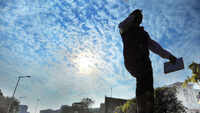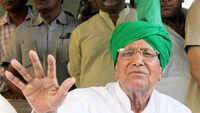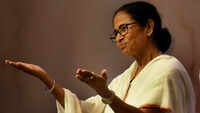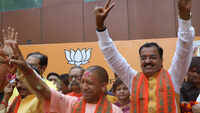
RAJKOT: Gujarat escaped cyclone’s devastation, but on Sunday it will be reminded of a cataclysmic shaking of the earth that totally changed the topography of Kutch desert.
On June 16, it will be exactly 200 years to ‘Allah Bund,’ considered as the biggest earthquake to hit the Indian sub-continent. The tremblor, which created a ridge 90 km long, 16km wide and 3-4 m high in Greater Rann - all in less than a minute - continues to intrigue geologists and earth scientists event today.
On Sunday, nearly 40 experts, including those from foreign countries, will converge at the Shyamji Krushna Verma Kutch University, to discuss this rare seismic phenomenon.
“The earthquake was the strongest in Indian earthquake history and one of the greatest in intra-plate earthquakes of the world,” said Professor M G Thakkar of the department of earth and environmental science, Kutch university, while talking to TOI.
“Apart from the 90 km long ridge, the major revenue collection centre – the Sindri fort – was also devastated and many vessels and ships had been destroyed near the channel that led to the Kori creek. Rice fields near the Sunda region at Lakhpat also affected and inundated by the sea water,” said Thakkar. who asserts that no earthquake reported thereafter has made such huge topographical changes.
“N early 1000sq km land subsided by four metres. There was subsidence on the north and south sides too, while a port that existed ahead of Kori creek too subsided,” he added.
Scientists will study and analyze the magnitude of this disaster and visit the epicentre on Sunday. The national-level workshop on the intra-plate earthquake has been organized by the Department of Earth and Environment Science of Kutch University and Seismological Research, Gandhinagar.
Most of these experts have worked on the 1819 earthquake and its co-seismic deformation and also continue to work on it. Experts will deliberate on Palaeoseismic studies of 1819 ‘Allah Bund’ earthquake and comment on quaternary landscape evolution of the western great Rann of Kutch and structures and active tectonics and seismotectonics of ‘Allah Bund’ fault.
Talking about the purpose of the workshop, Thakkar said: “The amount of study produced on 1819 Allah Bund earthquake is very less. The earlier studies by Burnes (1826, 1828), Oldham (1926) and the verbal reports in the gazetteer, besides some early notes by international travellers give us vague ideas of the severity of the earthquake.”
He further said that the active interactions of existing experts’ understanding of the Allah Bund and fresh research ideas of young earth scientists will open up innovative research windows for the less understood domains of Rann of Kutch.
On June 16, it will be exactly 200 years to ‘Allah Bund,’ considered as the biggest earthquake to hit the Indian sub-continent. The tremblor, which created a ridge 90 km long, 16km wide and 3-4 m high in Greater Rann - all in less than a minute - continues to intrigue geologists and earth scientists event today.
On Sunday, nearly 40 experts, including those from foreign countries, will converge at the Shyamji Krushna Verma Kutch University, to discuss this rare seismic phenomenon.
“The earthquake was the strongest in Indian earthquake history and one of the greatest in intra-plate earthquakes of the world,” said Professor M G Thakkar of the department of earth and environmental science, Kutch university, while talking to TOI.
“Apart from the 90 km long ridge, the major revenue collection centre – the Sindri fort – was also devastated and many vessels and ships had been destroyed near the channel that led to the Kori creek. Rice fields near the Sunda region at Lakhpat also affected and inundated by the sea water,” said Thakkar. who asserts that no earthquake reported thereafter has made such huge topographical changes.
“N early 1000sq km land subsided by four metres. There was subsidence on the north and south sides too, while a port that existed ahead of Kori creek too subsided,” he added.
Scientists will study and analyze the magnitude of this disaster and visit the epicentre on Sunday. The national-level workshop on the intra-plate earthquake has been organized by the Department of Earth and Environment Science of Kutch University and Seismological Research, Gandhinagar.
Most of these experts have worked on the 1819 earthquake and its co-seismic deformation and also continue to work on it. Experts will deliberate on Palaeoseismic studies of 1819 ‘Allah Bund’ earthquake and comment on quaternary landscape evolution of the western great Rann of Kutch and structures and active tectonics and seismotectonics of ‘Allah Bund’ fault.
Talking about the purpose of the workshop, Thakkar said: “The amount of study produced on 1819 Allah Bund earthquake is very less. The earlier studies by Burnes (1826, 1828), Oldham (1926) and the verbal reports in the gazetteer, besides some early notes by international travellers give us vague ideas of the severity of the earthquake.”
He further said that the active interactions of existing experts’ understanding of the Allah Bund and fresh research ideas of young earth scientists will open up innovative research windows for the less understood domains of Rann of Kutch.
World Cup 2019
Trending Topics
LATEST VIDEOS
More from TOI
Navbharat Times
Featured Today in Travel
Quick Links
Lok Sabha Election Schedule 2019Lok Sabha Election NewsDelhi Capitals teamMI team 2019Rajasthan Royals 2019RCB team 2019Maharashtra Lok Sabha ConstituenciesBJP Candidate ListBJP List 2019 TamilnaduShiv Sena List 2019AP BJP List 2019Mamata BanerjeeBJP List 2019 MaharashtraPriyanka GandhiBJP List 2019 KarnatakaAMMK Candidate List 2019BJP List 2019 WBLok Sabha Elections in Tamil NaduBSP List 2019 UPNews in TamilLok Sabha Poll 2019Satta Matka 2018PM ModiMahagathbandhanNagpur BJP Candidate ListChandrababu NaiduTamil Nadu ElectionsUrmila MatondkarNews in TeluguMadras High CourtTejashwi YadavArvind KejriwalTejasvi SuryaPawan KalyanArvind KejriwalYogi AdityanathJaya PradaSatta King 2019Srinagar encounter
Get the app







